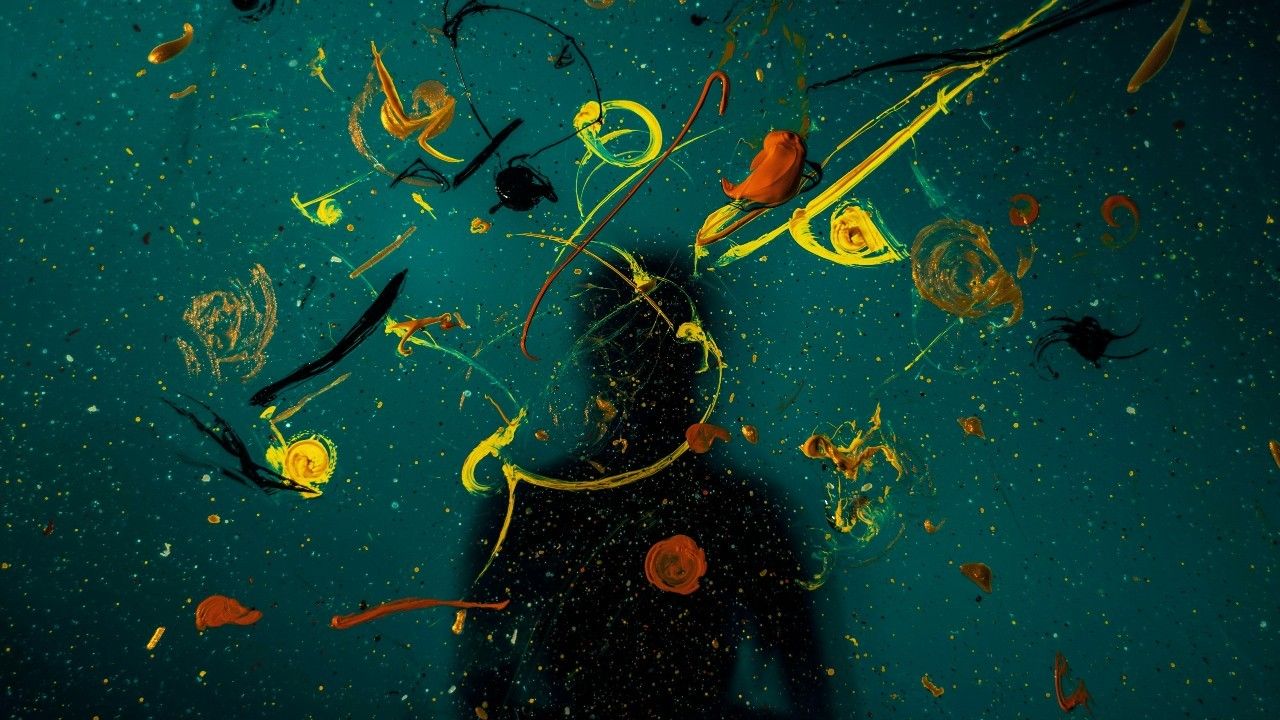Contents
- Introduction
- Theatres at a Glance
- History
- Building the Artistic Caucus
- The Caucus Begins
- Resource Sharing Systems
- First Year Learnings
- Going Forward: The Second Year
I. Introduction
*** This report describes the origins, development, and learnings of the Artistic Caucus, a collaborative initiative between Baltimore Center Stage, Long Wharf Theatre, Repertory Theatre of St. Louis, and Woolly Mammoth Theatre Company. The program seeks to disrupt traditional curatorial practices by employing a racially and geographically diverse collective of freelance artists to identify new work, scout projects, and facilitate relationships on behalf of all four theatres.
The Artistic Caucus was not conceived as an internal exercise; one of the project’s success metrics is the extent of public reporting. The four theatres view this program as a field-wide experiment and are committed to sharing discoveries, obstacles, and reflections throughout the process.
In the spirit of that transparency: the four theatres jointly hired me as the project documentarian in January 2022, four months after the initiative’s launch. I have constructed my understanding of that early time through meeting minutes, internal and external documentation, and extensive conversations with the artists and staff members. Since January 2022, I have attended every meeting, summit, and check-in (with a few exceptions) and conducted exit interviews with the four inaugural Caucus members.
This essay will summarize the project’s genesis, the institutions, and the key collaborators, as well as describe the inaugural year of the Artistic Caucus, which ran from September 2021 to September 2022. A second essay, to be published later this year, will document the second year of the program, which underwent a radical restructure.
*** II. Theatres at a Glance
The artistic directors of the four theatres share complementary values and visions, but their organizations have varying budgets, staffs, and seasons. To contextualize this collaboration—and the multi-year, field-wide impact of the pandemic—it’s crucial to illustrate the financial past, present, and ongoing post-shutdown recovery of these institutions.
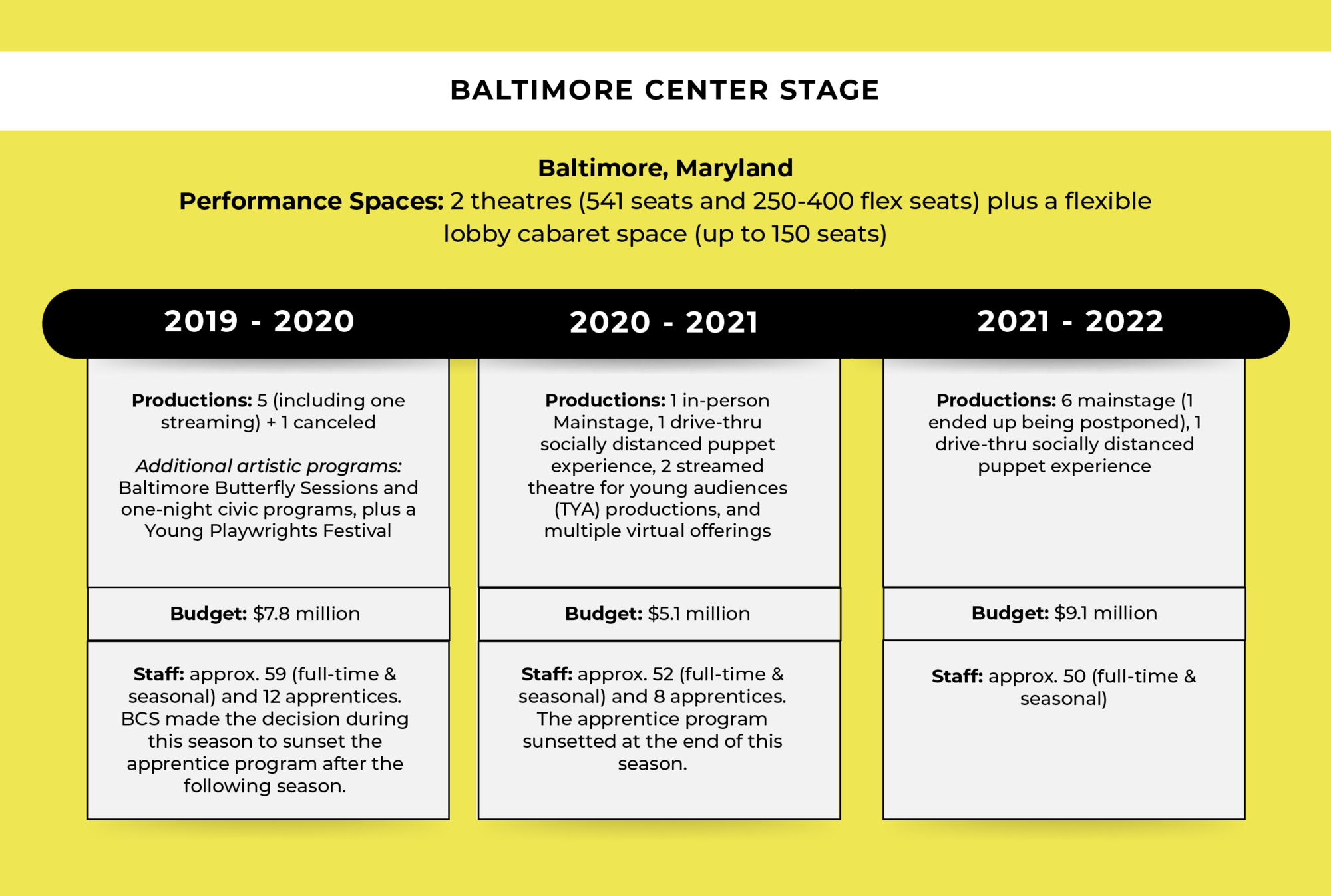
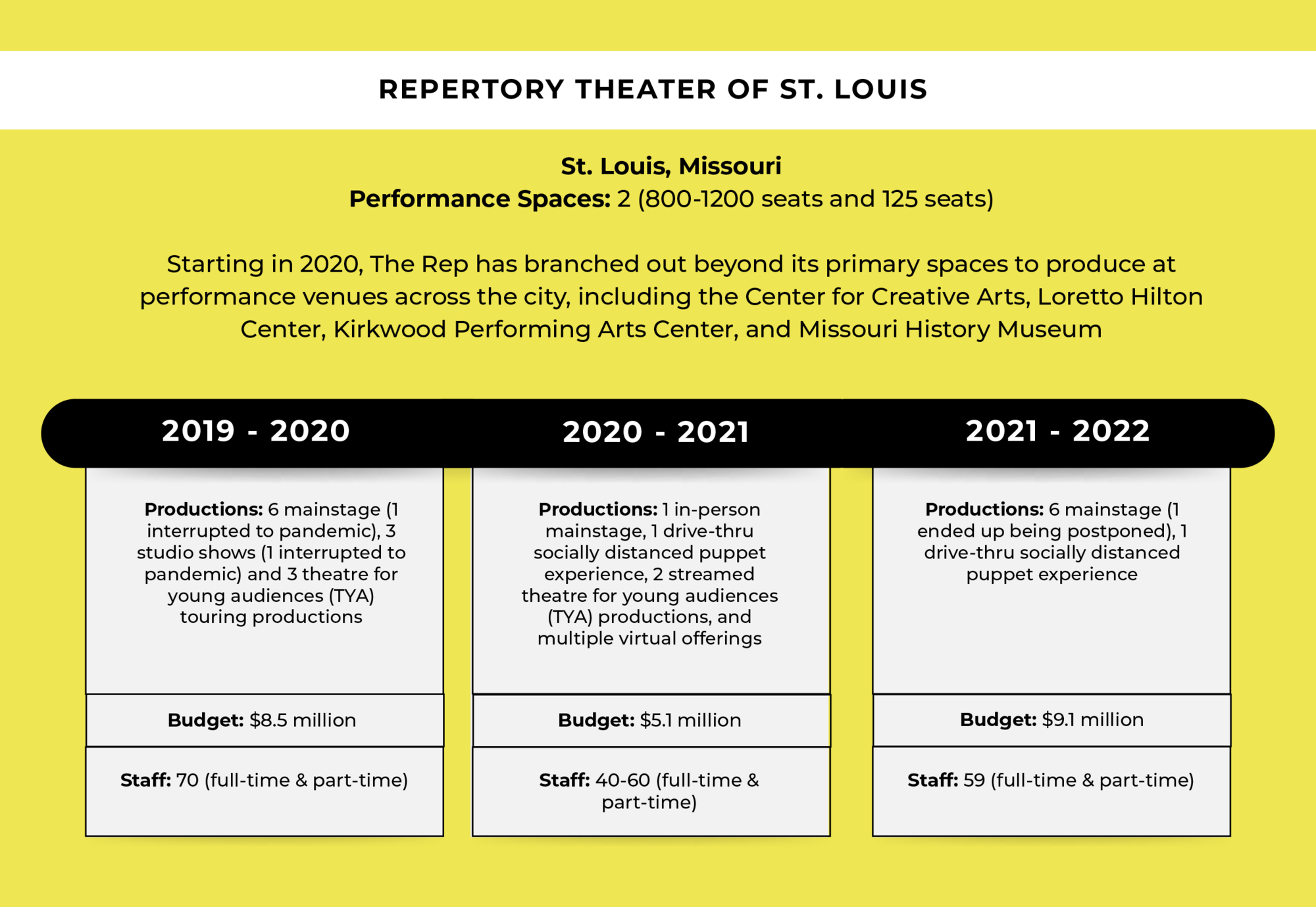
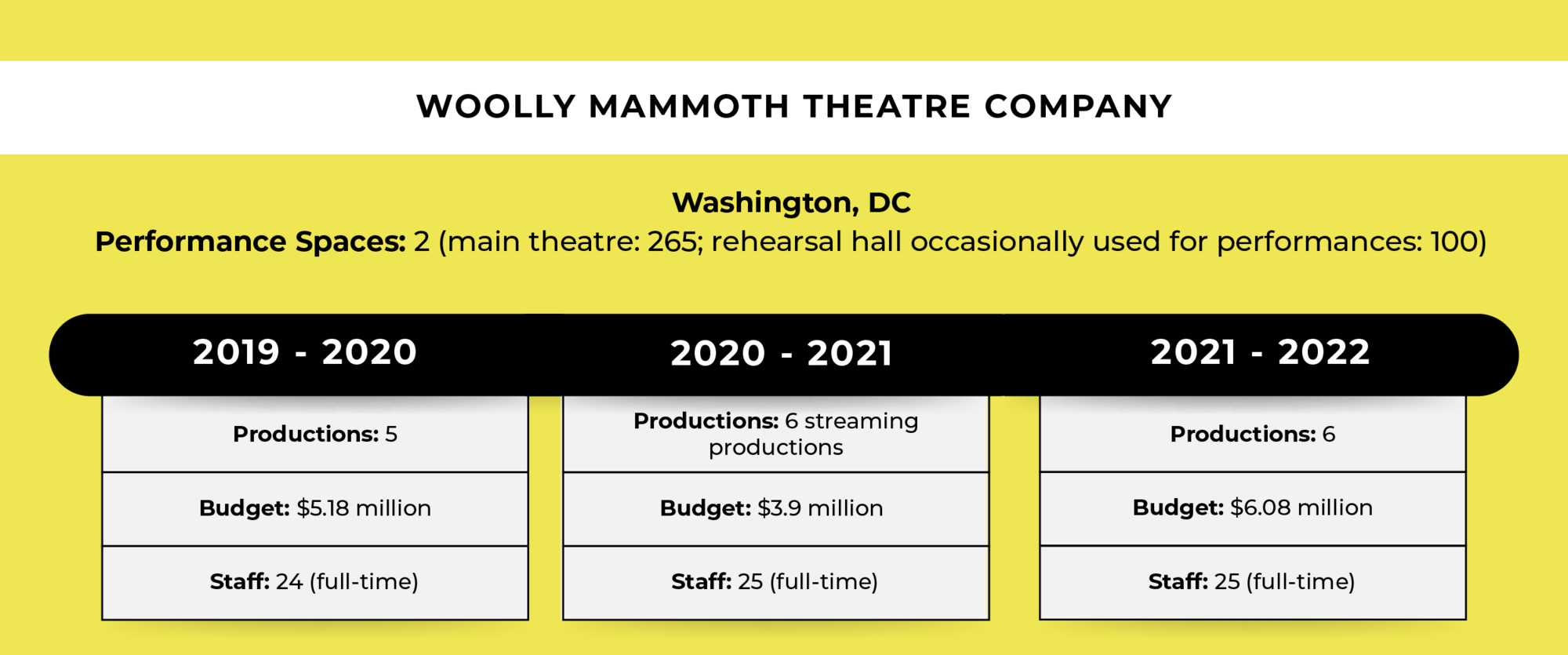

***III. History
In 2017, American Theatre noted over twenty open artistic director vacancies across the country, heralding a historic generational shift and a potential sea change in institutional leadership. A demographic transformation was appallingly overdue: The Wellesley Centers for Women’s 2016 survey reported that 73 percent of League of Resident Theatres (LORT) artistic directors were white men. There was one female artistic director of color.
By 2019, more than one-third of LORT theatres had hired new artistic directors. Bay Area artists Rebecca Novick and Evren Odcikin tracked and compiled race and gender statistics of this ongoing game of thrones: between 2015 and 2021, incoming theatre leadership was still disproportionately white and male.
The small influx of Black, Indigenous, people of color (BIPOC) leaders faced numerous challenges: the customary fiscal issues, board skepticism and obstinance, attracting new audiences without alienating subscribers and donors, and the impossible pressure imposed on leaders of color to “fix” or reinvent institutions. Among this initial wave of newly appointed artistic directors were Maria Manuela Goyanes at Woolly Mammoth Theater Company in Washington, DC; Jacob G. Padrón at Long Wharf Theater in New Haven, Connecticut; Hana S. Sharif at the Repertory Theater of St. Louis in St. Louis, Missouri; and Stephanie Ybarra at Baltimore Center Stage in Baltimore, Maryland.
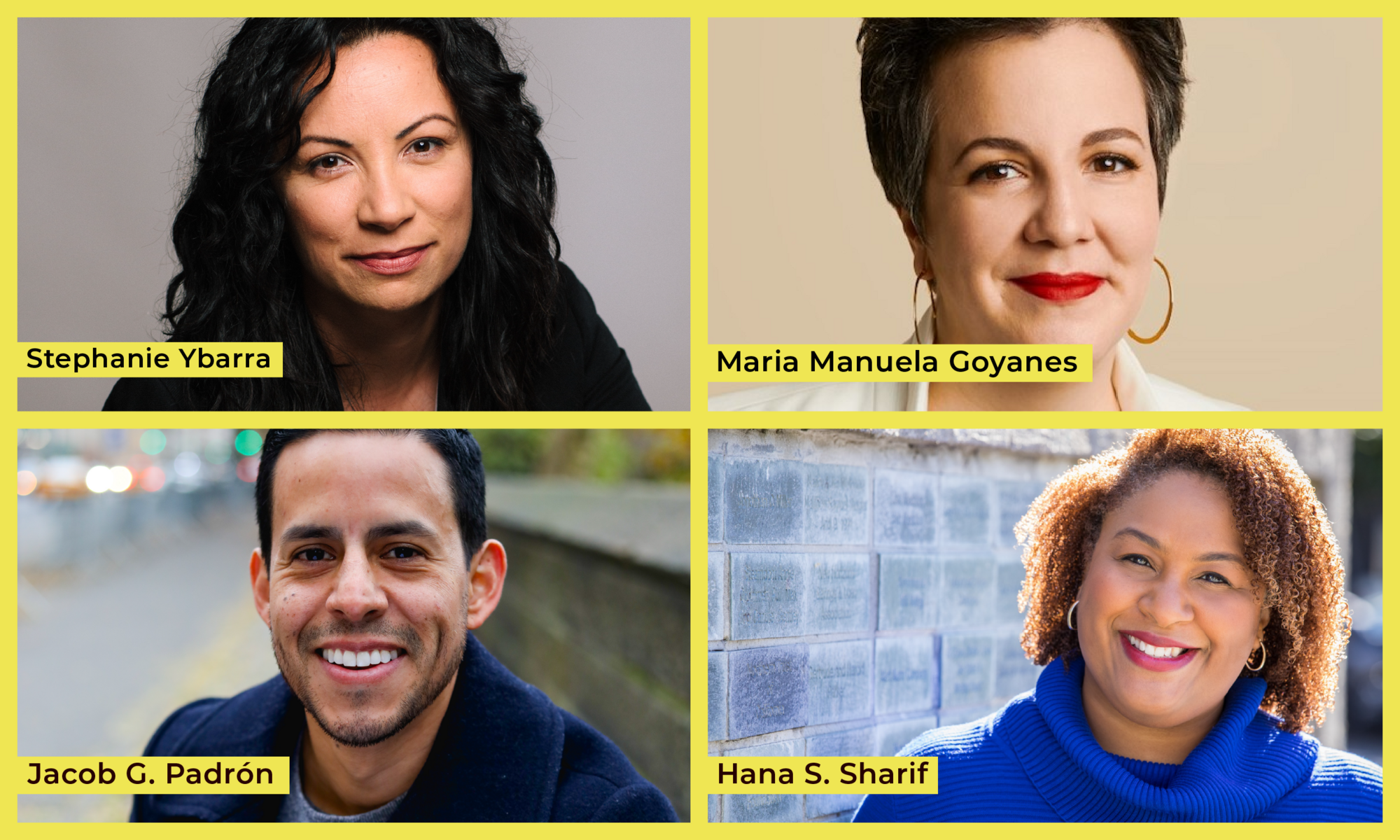
This quartet had informally collaborated in the past, but they intentionally assembled in late 2018 to share experiences, brainstorm joint collaborations, and devise strategies for remaking predominantly white institutions. The four artistic directors became an informal cohort, united by the vision of “creating artistic homes across the country that are inclusive, intersectional, and focused on the liberation of all people, using transparency, shared learning, and collective resource mining.” Implicitly, their vision was the opposite of the scarcity model, described by David Dower in his 2014 HowlRound essay as the widespread belief among nonprofit theatres that they exist “in a zero-sum universe, where everything I have means one less thing that you can have.”
The artistic director cohort’s inception barely preceded a time of genuine scarcity: the COVID-19 pandemic. The American theatre ecosystem underwent dramatic transformation: massive layoffs, catastrophic finances, an eighteen-month shutdown of live performance, and a field-wide examination of institutional racism. The George Floyd protests in 2020 ignited a national racial reckoning, days before the launch of the long-gestating We See You, White American Theatre. The decentralized collective of BIPOC theatre workers released an “omnibus declaration of interlinked strategies” demanding an antiracist, equitable, and sustainable theatre industry. In response, many theatres developed and released action plans detailing how they would combat pervasive racism, erasure, and white supremacy within their organizations and artistic programming, vowing to eradicate discriminatory hiring practices, increase onstage BIPOC representation, and adopt more humane rehearsal schedules, among other changes.
With the goal of creating new artistic development pathways, the Caucus would comprise four multidisciplinary artists who would scout projects, pitch ideas for future seasons, and broker connections within their individual communities.
As the social and political climate intensified, the ideas and questions that inspired the artistic director cohort’s formation rattled anew. How do organizations dismantle oppressive systems to foreground access and inclusion? How do theatres resist gatekeeping and expand their networks of influence, cultivating and sustaining meaningful relationships with freelance artists? And in a time of deep turmoil and uncertainty, can the American theatre reject scarcity and embrace abundance and interconnection?
***IV. Building the Artistic Caucus
The Artistic Caucus was one proposed component of the artistic director cohort’s wide-ranging collaboration. In late 2020, the four theatres applied to, and secured joint funding from, the Mellon Foundation and the Doris Duke Charitable Foundation in support of resource sharing and collaborative prototype projects and experiments across two fiscal years. (The funding was later extended due to the pandemic). The Artistic Caucus received a two-sentence-long cameo in that proposal:
The creation of an Artistic Caucus composed of racially diverse artists, who will assist in cultivating new works for the four theatres, with other duties that will organically develop over the course of the grant period. These [twelve-month] positions will have a built-in assessment to grow, deepen or pivot activity in year two.
To bring the Artistic Caucus from idea to implementation, the artistic director cohort recruited key staff members; these individuals colloquially referred to themselves as “The Cuatro” and began meeting regularly in February 2021. The group initially included Annalisa Dias, director of artistic innovation and partnerships at Baltimore Center Stage; Sonia Fernandez, director of new work at Woolly Mammoth; Cheyenne Barboza, artistic associate, community at Long Wharf; and Becks Redman, associate artistic director of Repertory Theater of St. Louis. (Kate Moore Heaney would later take over as Long Wharf’s primary Cuatro member in January 2022.)
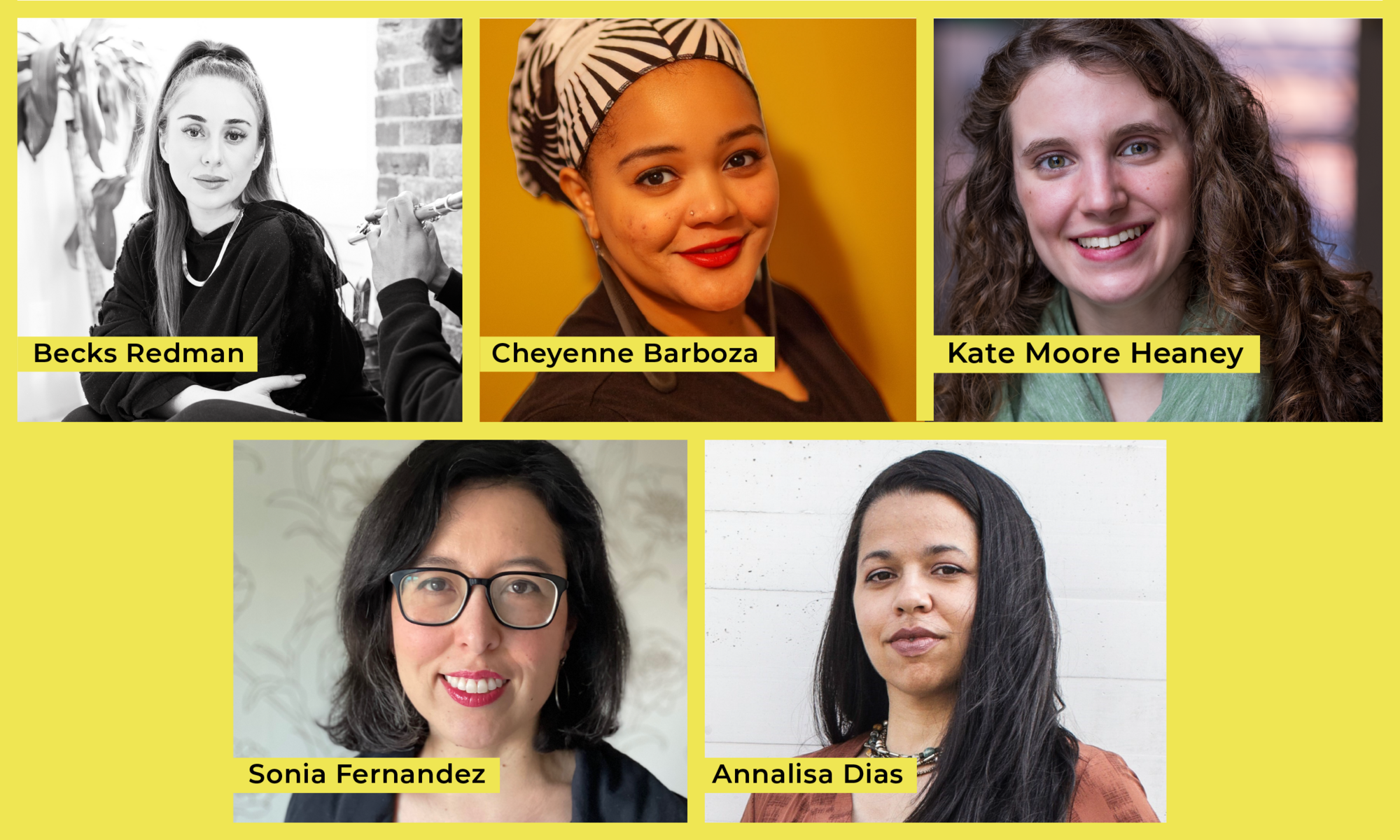
Each member already had a dizzying array of responsibilities at their respective theaters: Fernandez led Woolly’s entire new work and commissioning enterprise. Redman’s duties sprawled across line producing, budgeting, contracting, casting, and literary management. Dias directed Baltimore Center Stage’s civic programs and new work development; later, she absorbed managing rentals/community space and interim producing the Young Playwrights Festival. Barboza and Moore Heaney split season planning, production dramaturgy, new play development, public programming, and audience engagement work.
The busy cross-institutional collaborators began formulating the Caucus’ structure and processes. With the goal of creating new artistic development pathways, the Caucus would comprise four multidisciplinary artists who would scout projects, pitch ideas for future seasons, and broker connections within their individual communities. Although the Cuatro avoided predefining the program’s strategies and deliverables—to allow the four artists room to devise their purpose and output—they did establish virtual meeting requirements: biweekly gatherings with the Cuatro and quarterly summits with the artistic directors. The Cuatro would also meet separately on a weekly basis for agenda planning and scheduling.
The compensation was notable: each Caucus member would receive $15,000 (paid in monthly installments of $1,250), as well as $5,000 to spend on theatre tickets, travel, and other scouting expenses. The time commitment was advertised as ten hours per week.
After months of planning, applications opened in June 2021. The selection criteria were designed to maximize the Caucus’ diversity across age, gender, race/ethnicity, artistic discipline, and experience, but particularly location; choosing Caucus members from outside the theatres’ cities would help encourage connections with different regional creative communities. The application also specifically sought individuals who didn’t solely identify as dramaturgs or literary managers, as the theatres wanted “artists whose perspectives will disrupt the ‘normal’ systems for artistic development.”
Out of 120 submissions, eighteen candidates received first-round interviews with Cuatro members, with ten advancing to final interviews with the artistic directors. After a two-month process, the theatres selected Marie Cisco, Nailah Harper-Malveaux, Adil Mansoor, and Regina Victor as the four inaugural Caucus members.
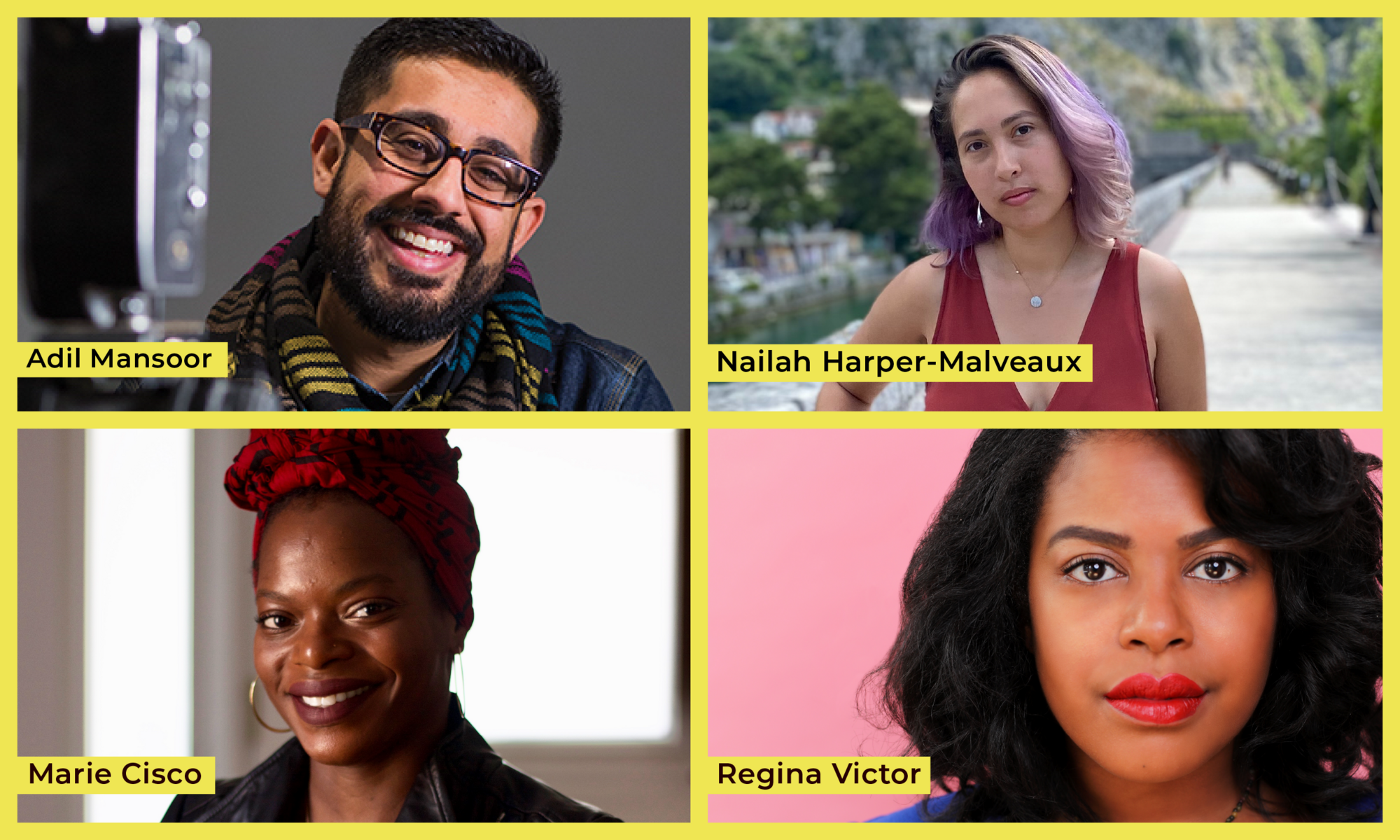
Cisco lived in Atlanta, where she produced film, television, and theatre projects. Harper-Malveaux’s work consisted of directing, community organizing, and producing across the Bay Area. Pittsburgh-based Mansoor worked as a director, deviser, educator, and performance artist. Victor balanced directing, dramaturgy, and criticism with their role as the artistic director of the Chicago storefront Sideshow Theatre Company.
These four theatremakers were drawn to the program for myriad reasons: building platforms to amplify artists and interdisciplinary work, interrogating and eradicating gatekeeping, connecting with four artistic leaders of color, and collectively rethinking institutional artistic development. The geographic flexibility (it was not unusual to have four time zones represented in meetings), compensation, and discretionary scouting fund were appealing components for freelance artists. There was also curiosity and excitement around the application’s language on decentering the written word and embracing generative artists beyond playwrights. “It’s thrilling to experiment with a curatorial model that resembles a devising process and encourages emergent possibilities,” said Mansoor.
***V. The Caucus Begins
In September 2021, the Caucus assembled on Zoom for their first meeting. Over the next year, they also gathered for meetings with the Cuatro and summits with the artistic directors.
Biweekly Meetings
The Caucus met twice a month to share scouting reports, recommend artists, and discuss current institutional and field-wide issues. The structure and scope of the Caucus’ work was amorphous at the onset, as the Cuatro wanted to provide space for them to tailor the program to their strengths.
But this initial freedom led to confusion about expectations and accountability metrics, as the Caucus wanted more explicit guidance from the Cuatro on their scouting benchmarks and meeting deliverables. Similarly, although Caucus members were deliberately selected to expand connection beyond the artistic director cohort’s institutions, the group desired more context on the theatres’ programming and challenges to help steer their recommendations. (In a different timeline, the Caucus would have traveled to meet the staff and see a production at each theatre, but the pandemic and the organizations’ staggered reopening plans prevented site visits.)
Thinking outside the traditional institutional framework required intense creativity and labor from all participants.
In response to these Caucus concerns, the Cuatro started providing prompts for active season planning needs: cabaret acts, new work by trans artists, classics ripe for reinvention, directors to reimagine popular comedies. This framework was incredibly useful for the Caucus, as it focused the group’s efforts and provided insight into the theatres’ interests and aesthetics.
The meetings also evolved to demystify the season planning process, contextualizing artistic decision-making (as Redman once explained, “The Rep produces A Christmas Carol every year which helps offset the costs of producing a new play”) and post-pandemic financial obstacles. The open discussion allowed the Caucus to thoughtfully challenge practices while also understanding institutional roadblocks.
The scouting component of the program had its own COVID-era complications. The Cuatro originally hoped the discretionary funds would subsidize a mix of Caucus-dictated travel and festival coverage assigned by the theatres. As the Caucus commenced in September 2021, the industry was slowly reopening for live performances—right before the Omicron variant surge derailed winter schedules. With in-person theatre and travel in flux, there was limited discussion and upfront strategizing around the Caucus’ scouting funds. The money was ultimately spent at each member’s discretion.
Role clarity, murky expectations, and general ambiguity are all expected hurdles of a pilot program. Thinking outside the traditional institutional framework required intense creativity and labor from all participants. Over their year of meetings, the Cuatro and the Caucus were constantly responding and readjusting to create a mutually beneficial, intentional space for discovery and connection. When the Caucus animatedly hyped artists from their communities, or pitched their season planning prompt responses, their infectious energy activated the virtual space. In these moments, the program’s potential reach and impact crystallized.
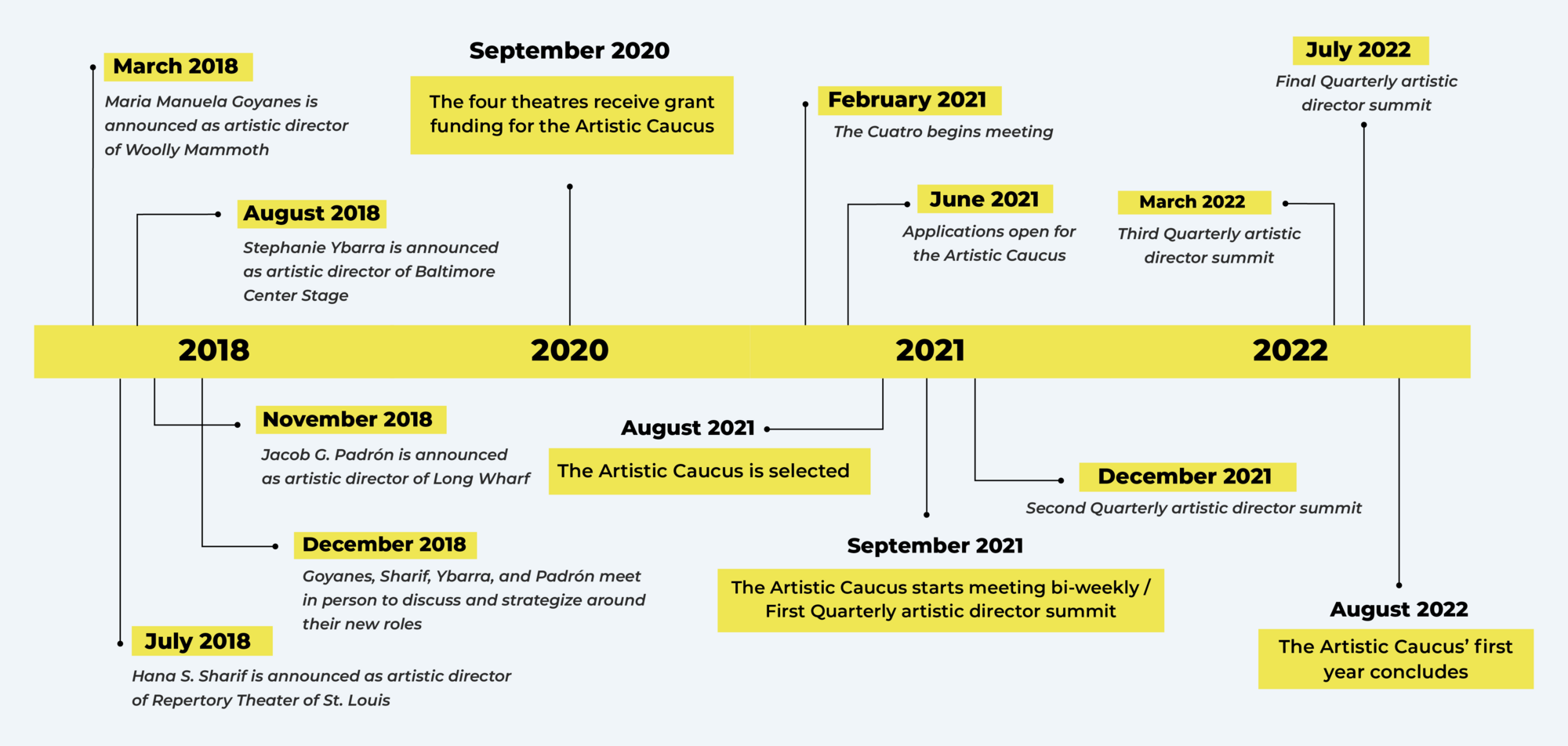
Quarterly Artistic Director Summits
The Caucus met quarterly with the four artistic directors to directly recommend artists and projects; the leaders also shared their institutional visions, current needs, and ongoing challenges. While the meetings were scheduled a year in advance—finding the same available ninety-minute time slot for all four artistic directors was a Herculean task for their executive assistants—the format was determined a few weeks prior to each meeting.
The first summit in September functioned as an introduction to the theatres’ missions, programming, and visions for the future. The next meeting in December revolved around a joint reading exercise. The Caucus asked the artistic directors to read four to five pieces. Victor facilitated an extended conversation around one play and its programmatic feasibility at each of the theatres. Learning the balance between each artistic director’s individual taste and curatorial responsibilities was invaluable for the Caucus. But given the limited number of summits—and the program’s goal of expanding the number of voices around the table and under consideration—it didn’t feel prudent to focus on a singular work at future meetings.
Robust artistic presentations comprised the March summit. The Caucus received fifteen-minute slots to pitch artists, share videos and materials, and answer questions from the artistic directors. The foursome showcased an eclectic range of genre-bending creations: Mansoor focused on interdisciplinary, non-text-based storytellers and choreographers; Cisco shared site-specific collaborations, solo performances, and dramatizations of the immigrant experience; Harper-Malveaux highlighted community-based theatre collectives, Indigenous artists, and musicals; and Victor championed Chicago-based performers, a raucous queer feminist cabaret, and disabled theatremakers.
The enthusiasm and dialogue that swirled around each artistic presentation felt like an articulation of the program’s boundary-breaking vision. The Caucus loved hearing the artistic directors’ real-time, unfiltered feedback, and the artistic directors valued the balance of immediacy (connecting with actors for upcoming productions) and investment (building long-term relationships with artists). The opportunity to connect with theatremakers lacking widespread industry recognition—“thought leaders, rather than tail-chasers,” as one artistic director commented—appealed to all of the theatres.
The final summit in July concluded with every Caucus member having a thirty-minute, one-on-one conversation with each artistic director in breakout rooms. The Caucus could use the time to pitch projects, but they were encouraged to talk about their own artistic practice, ask professional development questions, and bolster their existing rapport with the artistic directors.
***VI. Resource Sharing Systems
In order to track work generated, scouted, and recommended by the Artistic Caucus, the theatres needed to create a shared information system integrated with an efficient, accessible documentation process.
The Database
The Cuatro contracted creative producer Sophie Blumberg in January 2022 to create an Airtable database. (Most of the theatres already used the platform for literary management.) While the database would initially be separate, the Cuatro wanted to eventually incorporate the data into each institution’s Airtable, creating a reciprocal flow of information and avoiding duplicate work.
One of the highest design priorities was a range of data exportation options to serve all four theatres, as well as the idiosyncratic needs of their artistic directors. The Cuatro wanted to visibly communicate the volume and variety of work under consideration, while also easily isolating data for specific inquiries. In addition to creating custom reports, the database was also designed to generate automated email digests summarizing recent data additions.
The first draft of the database was finished in April. The Caucus tested and troubleshot the evaluation submission process. They raised important confidentiality questions: would their internal notes and observations be available for future Caucus members to read? What would happen if an artist stumbled across old reports reviewing their work? To protect the integrity of the Caucus’ work, it was decided that future members would not have access to past evaluations.
As the database arrived relatively late in the Caucus’ tenure, there wasn’t adequate time for training or meaningful implementation into their reporting process. Harnessing its untapped potential and integration into each theatre’s existing tracking systems will be a focus of the program’s second year.
The Documentation
As the database’s design and functionality took shape, the Caucus and the Cuatro worked through the knotty documentation process.
At the start of the program, Caucus members recorded their scouting experiences using a Google form. But as the year went on, writing formal reports became an administrative burden. There were concerns that the time-consuming activity fell outside the Caucus’ weekly 10-hour commitment. Some Caucus members also expressed that a writing-heavy evaluation process was inaccessible and at odds with the initiative’s stated interest in “decentering the written word,” as people process and convey information in a variety of ways, including but not exclusively through writing.
The Cuatro and the Caucus both desired an efficient but accommodating system to record essential information, respect time, and foreground accessibility while recognizing the existing bandwidth strains on both parties. Mansoor proposed rotating live note-taking during the biweekly meetings: as Caucus members pitched artists or shared reflections, another member would capture the information. This allowed the Caucus to equitably share documentation responsibilities and reduce their report-writing time outside of meetings.
***VII. First Year Learnings
- This Is a Long Game
A massive component of institutional artistic planning is building long-term relationships. Season planning can feel like a sprint, but it’s really a marathon, nurturing collaborations that may take years to bloom. The Artistic Caucus created a space adjacent to but separate from the annual mad dash to season announcement, focusing instead on planting seeds for the future. The program’s impact was about creating possibility and creative longevity, brokering introductions with a veritable trove of under-the-radar artists across the country. It reframed season planning as its own valuable generative process.
- Disruption via Expansion
Creating a new avenue for independent artists to pitch projects expanded each theatre’s relational circles. Bypassing agents and the usual pipeline of New York and festival exports diversified the range of work under consideration. The program was also an experiment in creating ongoing, paid work for freelance artists at institutions. Several Caucus members noted the compensation was a boon for their finances and artistry, alleviating stress over living expenses and enabling their creative work. And while the crux of Caucus activities revolved around advocacy and deep-thinking, the program allowed these artists to build their own individual relationships with the theatres as artists. (One artistic director commented, near the end of the program, that they were ready to work more deeply with each Caucus member and that these connections were the initiative’s greatest success.)
The program purposefully centered the artists’ experience, but the theatres needed time to identify and articulate their goals for the Caucus in terms of duties and deliverables.
3. Bandwidth Struggle Is Real
Creating, managing, and participating in the Artistic Caucus was a labor-intensive process. All parties often remarked they were “building the plane as they were flying it,” which required additional agility.
The combination of onboarding, constant agenda planning and goal-setting, and the flexibility needed to rework policies, required significant investment from the Cuatro. They acknowledged that setting expectations early, especially around administrative responsibilities, was necessary for future Caucus iterations. There were also several components of the program—the database training and incorporation, integrating script reading into the Caucus’ work—that weren’t activated due to scheduling and bandwidth.
The Caucus members also faced time constraints. As the year progressed, Caucus attendance at biweekly meetings decreased due to various conflicts. (The biweeklys were scheduled on Friday afternoons; travel logistics and rehearsal schedules made achieving quorum difficult, which led to less dynamic meetings.) Some members noted that generating reports felt like it was about hitting quotas; simultaneously, there was a real need and desire among the Cuatro to retain information and archive the Caucus’ work.
Capacity issues complicated the feedback process. The Caucus didn’t always receive responses on their reports or pitches, due to the jam-packed schedules of the Cuatro and artistic directors. Creating a sustainable communication loop was an acknowledged area for improvement.
4. Flexibility First
Flexibility defines reinvention: a rare—and rarely achieved—quality among American theatres. The Artistic Caucus experiment required constant modification as the parties identified problems, brainstormed solutions, then piloted new ideas. The program purposefully centered the artists’ experience, but the theatres needed time to identify and articulate their goals for the Caucus in terms of duties and deliverables. After all, institutional initiatives, like new plays, require their own development process.
5. Creating Spaces to Dream and Connect
One of the great ironies of working on an artistic staff is how prioritizing open-ended conversations about theatre can feel indulgent, even irresponsible, amid the season planning crises, back-to-back meetings, and day-to-day emergencies. But as the Caucus found, dedicating time to dream, riff, and bond is crucial for collaboration and interconnection. (The Cuatro learned that maintaining that reflective space required rigor and thoughtful facilitation; one Caucus member noted that early group discussions about field-wide issues often veered into venting sessions, rather than creative strategizing.)
The program also deepened the Cuatro’s relationship, as they found solidarity and support with their institutional counterparts. Summit scheduling was a headache, but each artistic director was visibly grateful and excited to have meaningful face time with the Caucus. For most artistic leaders, fundraising, board-wrangling, and institutional profile-raising often take precedent over actual art-making. (Some members of the artistic director cohort were also combating intense racism from various organizational stakeholders.) As one artistic director commented, “You can think abundantly when you’re not constantly embattled.” The four summits provided a space detached from crisis mode, creating deeply dedicated time to connect with artists outside their usual orbit and articulate their long-term dreams for their organizations.
***VIII. Going Forward: The Second Year
The Cuatro pitched a radical reinvention of the program for its second year. Instead of one collective Artistic Caucus, it would be split into two groups: Readers and the Think Tank. In the job posting, these new positions were described as such:
- Each theater will hire two Artistic Caucus Readers (for a total group of 8). Readers will be responsible for reading and evaluating new work (plays, music, proposals for devised pieces, and more) from all four theaters, and the resulting reports will be shared among the theaters. We see this shared system as a way to disrupt the [gatekeeping] that so often happens across the field.
- The theaters will jointly hire a pool of 5 Artistic Caucus Think Tank members. These Think Tank members will be called upon on an as-needed basis by any of the 4 theaters’ new work staff for thought partnership, ideation, and artistic planning support. Think Tank members will be freelance artists from a variety of backgrounds, disciplines, and geographies. This group will provide an important range of perspectives and work very collaboratively with all four theaters.
The revised structure embraced the program’s value of creating abundance through opportunity by expanding the number of participants from four to thirteen. The Cuatro also wanted to proactively address the first year’s reticence to report-writing; the expanded number of participants helped to communicate work expectations and ease the individual time commitment at the outset.
Although the compensation was reduced (reflecting the decreased scope of labor), it still aimed to respect participants’ time and expertise. Think Tank members received a $400 retainer for no more than two meetings per month, while Readers received $25 per script report for up to four plays a month and would meet quarterly, allowing more time for meaningful feedback.
One of the inherent ironies of the Artistic Caucus is that it seeks to subvert traditional models, yet its existence relies on a conventional source: multi-year grant funding.
The Cuatro also took measures to reduce their administrative work by hiring a part-time coordinator. Casey Lucero joined in September 2022 to handle payments, meeting note-taking, reader report management, and additional communication support. Other funds were designated for the Cuatro to visit each other’s theatres, to allow the foursome to deepen their working relationships and brainstorm new ways for the four institutions to collaborate.
Two key components of the inaugural Artistic Caucus were de-emphasized for the second year. As the pandemic complicated the inaugural Caucus’ in-person scouting output, this responsibility was shelved to focus on other program areas. The Cuatro also did not plan quarterly summits with the artistic directors—arguably one of the most intellectually valuable and successful elements of the first year. The Cuatro made this change due to both the difficult scheduling logistics of the summits and the desire to experiment with new formats rather than replicate the first-year Caucus structure. Nonetheless, they worried that this shift reinforced gatekeeping and inequitable power dynamics between freelance artists and theatres. The extent of the artistic directors’ direct involvement with the new Caucus members remains an open question. (This is now further complicated by the departures of half of the artistic director cohort: Stephanie Ybarra announced in January 2023 that she would be leaving Baltimore Center Stage for a position with the Mellon Foundation, one of the Artistic Caucus’ primary funders. In April 2023, Hana S. Sharif was named the new artistic director of Arena Stage in Washington, DC.)
One of the inherent ironies of the Artistic Caucus is that it seeks to subvert traditional models, yet its existence relies on a conventional source: multi-year grant funding. The Mellon and Duke foundation support for the Caucus ends in June 2023. The second year’s revisioning will determine which (if any) program elements can be integrated, with the absence of external dedicated funding, into each institution’s budget.
This clash between disruption and sustainability—how to risk and innovate and optimize resources without draining institutional capacity—unfolds as several of the theatres are undergoing seismic change. In addition to Ybarra and Sharif’s exits, Long Wharf recently left its long-time theatre space and adopted an itinerant producing model. As these four companies navigate complex individual evolutions, they’re also discovering what an investment today in large-scale joint projects might yield—and require—tomorrow.
This piece, “The Artistic Caucus: How Four Theatres Joined Forces to Disrupt Curatorial Practices” by Lauren Halvorsen, was originally published on HowlRound Theatre Commons, on July 13, 2023.




